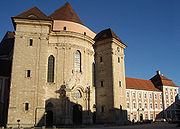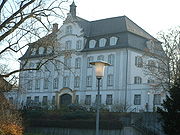
Johann Georg Specht
Encyclopedia



Lindenberg im Allgäu
Lindenberg im Allgäu is the second largest town of the district of Lindau in Bavaria, Germany. It is an acknowledged air health resort.-History:The town was first mentioned in 857, when two nobles donated estates in "Lintiberc" to the monastery of St...
. He was a civil engineer
Civil engineer
A civil engineer is a person who practices civil engineering; the application of planning, designing, constructing, maintaining, and operating infrastructures while protecting the public and environmental health, as well as improving existing infrastructures that have been neglected.Originally, a...
and architect
Architect
An architect is a person trained in the planning, design and oversight of the construction of buildings. To practice architecture means to offer or render services in connection with the design and construction of a building, or group of buildings and the space within the site surrounding the...
in the south of Germany
Germany
Germany , officially the Federal Republic of Germany , is a federal parliamentary republic in Europe. The country consists of 16 states while the capital and largest city is Berlin. Germany covers an area of 357,021 km2 and has a largely temperate seasonal climate...
.
Johann Georg Specht trained as a civil engineer with Peter Thumb
Peter Thumb
Peter Thumb was an Austrian architect whose family came from the Vorarlberg, the westernmost part of Austria. He is best known for his Rococo architecture, mainly in Southern Germany...
in Vorarlberg
Vorarlberg
Vorarlberg is the westernmost federal-state of Austria. Although it is the second smallest in terms of area and population , it borders three countries: Germany , Switzerland and Liechtenstein...
.
Specht planned and had a vast number of edifices
Building
In architecture, construction, engineering, real estate development and technology the word building may refer to one of the following:...
and other construction
Construction
In the fields of architecture and civil engineering, construction is a process that consists of the building or assembling of infrastructure. Far from being a single activity, large scale construction is a feat of human multitasking...
s built in Upper Swabia
Upper Swabia
Upper Swabia is a region in Germany in the federal states of Baden-Württemberg and Bavaria. The name refers to the area between the Swabian Alb, Lake Constance and the Lech...
and the Allgäu
Allgäu
The Allgäu is a southern German region in Swabia. It covers the south of Bavarian Swabia and southeastern Baden-Württemberg. The region stretches from the prealpine lands up to the Alps...
, amongst which are as varied constructions as water works, bridges, mills
Mill (grinding)
A grinding mill is a unit operation designed to break a solid material into smaller pieces. There are many different types of grinding mills and many types of materials processed in them. Historically mills were powered by hand , working animal , wind or water...
, residential buildings, industrial
Industry
Industry refers to the production of an economic good or service within an economy.-Industrial sectors:There are four key industrial economic sectors: the primary sector, largely raw material extraction industries such as mining and farming; the secondary sector, involving refining, construction,...
buildings and even castles and churches.
His main and most famous project was the monastery
Monastery
Monastery denotes the building, or complex of buildings, that houses a room reserved for prayer as well as the domestic quarters and workplace of monastics, whether monks or nuns, and whether living in community or alone .Monasteries may vary greatly in size – a small dwelling accommodating only...
church St. Martin
Martin of Tours
Martin of Tours was a Bishop of Tours whose shrine became a famous stopping-point for pilgrims on the road to Santiago de Compostela. Around his name much legendary material accrued, and he has become one of the most familiar and recognizable Christian saints...
at Wiblingen Abbey
Wiblingen Abbey
Wiblingen Abbey was a former Benedictine abbey which was later used as barracks. Today its buildings house several departments of the medical faculty of the University of Ulm. The former abbey is located south of the confluence of the rivers Danube and Iller, south of the city of Ulm in the German...
in 1771. He planned and designed the church but was not allowed to execute the building works when the Bavaria
Bavaria
Bavaria, formally the Free State of Bavaria is a state of Germany, located in the southeast of Germany. With an area of , it is the largest state by area, forming almost 20% of the total land area of Germany...
n painter
Painting
Painting is the practice of applying paint, pigment, color or other medium to a surface . The application of the medium is commonly applied to the base with a brush but other objects can be used. In art, the term painting describes both the act and the result of the action. However, painting is...
and civil engineer Januarius Zick
Januarius Zick
Johann Rasso Januarius Zick was a painter and architect. He is considered to be one of the main masters of the Late-Baroque.-Life:...
was contracted in 1778 to complete the building works after Specht had been dismissed in December 1777.
Works
- 1748-1750: industrial building at castle Ratzenried
- 1751: parish churchParish churchA parish church , in Christianity, is the church which acts as the religious centre of a parish, the basic administrative unit of episcopal churches....
in Eglofs - 1753: parish church in BaisingenBaisingenBaisingen is a suburban district of Rottenburg am Neckar in the administrative district of Tübingen in Baden-Württemberg .- Geography :...
near NagoldNagoldNagold is a town in southwestern Germany, bordering the northern Black Forest. It is located in the Landkreis of Calw . Nagold is known for its ruined castle, Hohennagold Castle, and for its road viaduct... - 1754: castle AmtzellAmtzellAmtzell is a municipality in the district of Ravensburg in Baden-Württemberg in Germany....
- 1855-1756: hunting castle and chapelChapelA chapel is a building used by Christians as a place of fellowship and worship. It may be part of a larger structure or complex, such as a church, college, hospital, palace, prison or funeral home, located on board a military or commercial ship, or it may be an entirely free-standing building,...
St LeonardLeonard of NoblacLeonard of Noblac or of Limoges or de Noblet , is a Frankish saint closely associated with the town and abbey of Saint-Léonard-de-Noblat, in Haute-Vienne, in the Limousin of France.-Traditional biography:According to the romance that...
in Rimpach near Leutkirch - 1765: extension of the parish church in Lindenberg/AllgäuLindenberg im AllgäuLindenberg im Allgäu is the second largest town of the district of Lindau in Bavaria, Germany. It is an acknowledged air health resort.-History:The town was first mentioned in 857, when two nobles donated estates in "Lintiberc" to the monastery of St...
- 1771: parish church in WiggensbachWiggensbachWiggensbach is a municipality in Bavaria. It is situated about 7 kilometres west of Kempten, the next greater town.Neighbour municipalities are Altusried in the north and Buchenberg in the south of the village. The municipality consists of Wiggensbach as the main village and Ermengerst and...
near Kempten/AllgäuKempten im AllgäuKempten is the largest town in Allgäu, a region in the south-west of Bavaria, Germany. The population was ca 61,000 in 2006. The area was possibly settled originally by Celts, but was later overtaken by the Romans, who called the town Cambodunum... - 1771-1778: church at Wiblingen AbbeyWiblingen AbbeyWiblingen Abbey was a former Benedictine abbey which was later used as barracks. Today its buildings house several departments of the medical faculty of the University of Ulm. The former abbey is located south of the confluence of the rivers Danube and Iller, south of the city of Ulm in the German...
- 1776-1779: castle Kleinlaupheim in LaupheimLaupheimLaupheim is a city in southern Germany in the state of Baden Württemberg. Laupheim was first mentioned in 778 and gained its city rights in 1869. One of the main trading routes, from Ulm to Ravensburg and then on towards Lake Constance ran through Laupheim...
- 1778: mail coach station in Kempten/AllgäuKempten im AllgäuKempten is the largest town in Allgäu, a region in the south-west of Bavaria, Germany. The population was ca 61,000 in 2006. The area was possibly settled originally by Celts, but was later overtaken by the Romans, who called the town Cambodunum...
- 1782: industrial buildings at IrseeIrseeIrsee is a village and municipality in the district of Ostallgäu in Bavaria in Germany.The centre of the village is dominated by a monastery , dedicated to the Virgin Mary, was founded in 1186 by Margrave Henry of Ronsberg to house a community that had grown up around a local hermit...
Monastery - 1786-1789: castle Neutrauchberg near Isny
- 1792: parish church in ScheideggScheideggScheidegg may refer to:*Scheidegg, Bavaria, a town in southern Bavaria*two Passes in Switzerland**Kleine Scheidegg **Grosse Scheidegg...
near Lindenberg im Allgäu

